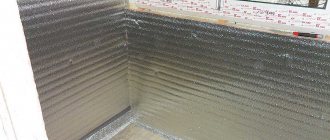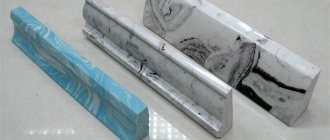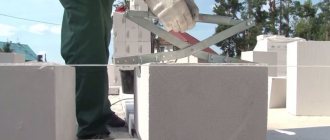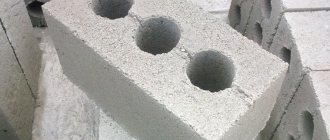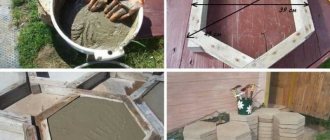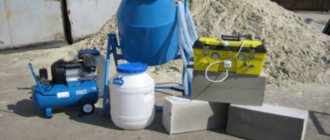The main stages of gluing concrete to various materials include identical steps that must be followed to obtain a reliable fastening.
Preparatory processes
Clean the concrete surface from dust and dirt. New surfaces do not require much preparation. Dust is removed with a damp brush. Repair involves cleaning of residual adhesive mixtures. Significant differences require additional leveling with a layer of cement mortar or plaster.
Primer
When gluing concrete to a variety of materials, concrete is primed! The adhesion of the cement surface, which was initially low, increases. There are several types of soil on the construction market:
- universal;
- deep penetration;
- specialized.
It is enough to treat a new concrete slab with a universal primer. Old concrete planes require deep penetration to bind molecular groups that have lost strength. Acrylic primers are the best choice, safe and practical. Polystyrene-based primer is highly toxic and is used only industrially.
Adhesive mixtures
A large number of adhesive compositions are produced for working with various materials. Dry, liquid, intended for specific surfaces ─ the choice is difficult. Concrete planes have a porous structure; universal mixtures are the most suitable option for gluing plastics, rubber, and plywood. If the compounds will be exposed to high humidity and temperature changes, it is better to use products containing deep-impact modifiers.
Ready-made mixtures are used; adhesive compositions are prepared immediately before starting work, strictly following the instructions indicated on the packaging:
- fill the container with water;
- Gradually pour out the dry mixture, stirring evenly to avoid lumps;
- leave to settle for ten to fifteen minutes;
- Stir thoroughly again.
Using a mixer or drill, completely immerse the rotating planes, eliminating splashing of the mixture.
Bonding procedure
Depends on the type of material and purpose of the surface. Smooth plane and tight fit are a guarantee of high-quality connection and durability of use.
PVC panels on the wall - instructions on how to glue with liquid nails
PVC panels as wall cladding are popular in non-standard renovations. Many colors, sizes, textures and a relatively low price make this material even more in demand. Before gluing PVC panels to the wall, we recommend that you learn more about their properties and installation methods.
This article contains a description of polyvinyl chloride panels. It covers:
Characteristics of PVC panels
If you want to know how to glue PVC panels correctly and on what? To do this, we first recommend studying their technical characteristics. The abbreviation PVC stands for polyvinyl chloride. This is a standard plastic with different additives to achieve the desired colors and shapes.
Among the advantages that this material has, the following factors are noted:
We recommend paying attention to the reputability of the manufacturer. We advise you to carefully inspect the product. Check it for possible defects and damage that could have been caused by improper storage or transportation.
Methods for attaching PVC panels to the wall
Installing PVC wall panels is not such a difficult task. Even an untrained person who has a minimal understanding of the principles of operation can handle it.
There are three methods of cladding a wall with polyvinyl chloride. Products can be secured to the sheathing with self-tapping screws, clamps, or glued with liquid nails.
Self-tapping screws on the sheathing
The sheathing is a frame made of wood, metal or plastic. This fastening method is used in rooms with very uneven walls. Correct lathing will eliminate the curvature of the covering, and then the repair will become more accurate.
The lathing is made by hand according to preliminary markings. Instructions for making it correctly are available on the Internet. Fastening is done with small self-tapping screws, which will remain visible on the front side.
Using clamps
These are small metal brackets that are secured to the frame with a few small nails. They are made from high quality galvanized steel. When installed using this method, these elements are completely invisible on the front side.
The advantages of clamps are a more durable attachment to the surface. You can also use this method when you need to cover uneven walls with panels.
Adhesive composition
How to glue on liquid nails? This method is much simpler than fastening with clamps. Its main advantage is saving space. Gluing will not reduce the area of the room, which is good for small rooms.
First you need to level all the walls and dry them, since adhesion with an uneven wall will be minimal. Repair experts advise using liquid nails for plastic. Some people glue PVC to tile adhesive, but it is preferable to choose special-purpose compounds.
Installation methods: yes or no
Plastic panels are mounted in three ways:
- fastening with liquid nails or glue;
- fixing to the wall with self-tapping screws;
- on lathing, metal, wood, plastic (mounting profile).
The first two options are suitable for owners of flat surfaces. Otherwise, all defects, even those camouflaged by plastic walls, will be an “eyesore.” But fixing PVC panels with self-tapping screws will disfigure the wall; the work will take a lot of time, nerves and effort. The neighbors will also not be happy, since a lot of holes for fastening will be required. Glue is the best option if the surfaces are relatively flat: it is possible to protect the walls from “wounds” and save precious space, which for some reason is always scarce.
The last method is a prerequisite if the differences in walls or ceilings are more than 3 mm. When there is no opportunity or desire to fight the curvature for a long time, it is hidden with the help of lathing. A frame is also necessary if the walls of the room are permanently damp, which happens very often in bathrooms.
How to glue PVC panels to a wall with liquid nails: instructions
You need to glue PVC panels onto liquid nails after preparing the walls. The master needs to remove all cracks, chips and irregularities from their surface.
Before work, we recommend that you clean the wall of any loose coating. To do this, you need to remove all the old wallpaper, remove a layer of peeling paint, etc. This will ensure effective adhesion of the materials to each other.
Tools
To glue PVC, you will need to stock up on specific equipment. Prepare the necessary tools and materials in advance:
The lining must first be unpacked. First, you should keep it in a warm room for several hours so that the panels reach room temperature.
Consumption
The consumption of liquid nails per m2 of plastic panels depends on several factors. These are the technical characteristics and initial density of the product. These indicators will be different for each brand of product. On average, one tube of glue is enough to secure five square meters of coating.
We advise you to buy liquid nails of a specific brand with a reserve, because you need to use the adhesive composition of one manufacturer. If you doubt that liquid nails will be able to hold plastic trim on the wall, we advise you to look at the master’s answer:
We recommend taking into account the density of material applied to one part. When working with PVC, it may not be the highest, since this material is lightweight and therefore quickly fixed to the surface.
How much do you need to install PVC liquid nails? You should first study the manufacturer's instructions. It indicates the approximate number of grams of fixing agent per square meter of the product.
Wall preparation: leveling
The strength of the finish depends on the alignment of the walls. You can do this yourself, without the help of repair specialists. It is performed according to the following instructions:
Work algorithm
Instructions on how to glue PVC panels to a wall are universal. Therefore, it can be used as a guide to working with liquid nails of any brand.
Avoiding mistakes when using panels
It is necessary to comply with basic technological requirements, otherwise even the best imported composition will not save you. Manufacturers of dozens of types of glue develop instructions that indicate how to glue PVC panels, but they do not write about the main mistakes. Let's try to fix the situation:
- It is strictly forbidden to bend the panels, this will lead to deformation and further replacement, due to a critical weakening of the base.
- Important! All parts must be kept warm for several hours so that they correspond to room temperature. Many buyers purchase building materials “in reserve,” placing them in garages and on balconies. You cannot glue cold PVC parts!
- There is no need to skimp on the use of antiseptics or on dust removal of the surface.
- Do not use an adhesive product not designed for PVC fastening. There is also no need to take risks and use expired glue that has been stored for a long time in improper conditions.
Choosing an adhesive composition
It is not necessary to give preference to the products of these particular companies. Almost every year new materials and even brands appear on the market. It is not at all easy to understand this abundance. What kind of glue should you use to glue PVC in your home?
Mixture from Russian
The annotation states that the mixture is capable of gluing plastics and polymers. Of course, the coating should be prepared properly. The mixture tolerates high humidity well. Hardening occurs quite quickly after applying the composition.
Kleiberit from Germany
The technology has been developed for a long time in German laboratories. The product is based on resin components obtained artificially; the glue is classified as universal. For PVC panels, German quality is unrivaled. Brand Features:
- Huge range of products for different materials.
- Ecological purity of all mixtures.
- Quick drying, maintaining working properties under the influence of high humidity levels.
- Compliance with the stated composition standards.
Titan Wild
Suitable for gluing lightweight PVC-based finishing materials. If we discuss which PVC glue is better in terms of properties and cost, then this product clearly deserves the attention of consumers.
There are certain restrictions regarding the basis. It is necessary to carefully prepare the wall before carrying out work. It is allowed to mount panels on a wide variety of bases. In particular, brick, concrete and plaster.
Useful tips
To firmly glue PVC panels, you need to strictly follow specific recommendations. It is important to remember that polyvinyl chloride is a material that does not withstand significant mechanical loads. Therefore, you should not put too much pressure on it with heavy objects.
This material does not cope well with the effects of aggressive chemicals, and therefore it should not be washed with the most concentrated detergents. To avoid mistakes, before work we advise you to study in detail how to glue PVC panels to the wall.
Source
About the surface
The surface itself must be almost perfect, so that there are no differences or other defects. Allowable curvatures should not exceed 4 mm. If the norms are exceeded, you will fail.
The surface should be prepared as follows:
First of all, the walls are primed so that all excess dust is removed from them. You can first use a vacuum cleaner to remove dust from the walls, and then cover the walls with a primer mixture.
Next, the walls need to be leveled so that the surface is vertical and there are no holes or bumps on them. The smoother your walls are, the closer the decorative panels will be to them.
Next, the walls are primed again. This is done so that the panels adhere well to the walls. This ensures good adhesion.
By and large, this is enough. On some sites you can find information that the walls need to be additionally puttied, but in our opinion this is a waste of money. If you putty on plastered walls, it won't be any worse, but it will cost you additional investment. There is an opinion that glue adheres more reliably to putty. This may be true, but if you don’t skimp on the primer and saturate the walls well with it, this will be more than enough for your PVC panels to stick well.
How to glue plastic (plastic panel, metal) to concrete at home
The question of how to glue plastic to concrete can become relevant when performing a variety of repair and construction work. PVC panels are quite popular and are widely used in cosmetic repairs. This is explained simply: plastic panels are inexpensive, come in a wide range of colors and shades, and are easy to install and maintain.
Using PVC panels you can quickly and easily tidy up a small office or utility room, make the walls in a store, administrative room, etc. more aesthetically pleasing. Due to the moisture resistance of the panels, they are often used to decorate bathrooms and toilets - practical, quick, and you can do everything yourself. But before you begin, it is important to study all the features and stages of the work.
Features of working with different materials
Construction and repair work involves the use of different materials: plastic, metal, rubber, drywall. Insulation of premises is carried out with polystyrene foam boards. There are certain features of working with different building materials.
Plastic
Plastic panels and tiles are popular finishing materials. They cover the walls and floor with it. An adhesive connection allows for easy replacement of a deteriorated surface without dismantling the entire area. Preparation for pasting is standard. The main question is how to glue the plastic to the concrete. There are special adhesive compositions for joining plastic panels and concrete slabs. The best option is spot-on, using liquid nails. A reliable connection will be ensured by adhesive and sealant; fungicidal antifungal elements allow the composition to be used in damp rooms.
Ruberoid
Rolled material is used for installing soft roofs and waterproofing surfaces. The first condition for installation on concrete is a dry surface of the slabs! Moisture will create a repulsive layer that negatively affects the strength of the connection; it will become impossible to glue the roofing felt to the concrete. The adhesive composition necessarily includes a bitumen component. The method of applying mastic is hot or cold. The roll is rolled out onto an evenly distributed adhesive layer, pressing the surfaces tightly with metal - tape or lath, laying the roofing felt on the concrete.
Description of PVC panels
The abbreviation PVC is a short form of the word polyvinyl chloride. The term refers to ordinary plastic material, plastic that has been shaped into the desired shape during the manufacturing process. For many years, PVC panels have been actively used as a finishing material, which has many advantages.
A huge selection of panel colors, with various designs and patterns. Such panels are great for quick and inexpensive repairs, but you should purchase them only from trusted suppliers who guarantee high quality products. Installation can be done at home yourself.
To avoid the need to soon repair or completely redo the finish, you need to pay serious attention to the choice of glue.
Glue for PVC panels - which is better?
There is a large selection of adhesives, so you won’t have to decide for a long time how to glue metal to concrete or plastic panels to a wall. But some types of glue cannot be used specifically with PVC, as they can deform the panel and ruin its appearance.
When choosing an adhesive, you need to remember that high cost is not always a guarantee of high quality and optimal choice. To decorate concrete walls with PVC panels, many people use Moment Montazh and Titan. But before purchasing, be sure to study the packaging labeling, instructions, and ask the seller for advice (if he has extensive knowledge and does not just indicate the most expensive composition).
For plastic panels, it is advisable to choose appropriate adhesives designed to work with polyvinyl chloride and concrete.
Types of glue
Installing panels with special glue is a simple and inexpensive way for novice builders to complete finishing work.
Adhesive compositions for this type of finishing work must have certain properties:
- moisture resistance - for reliable fixation of the structure in rooms with high humidity;
- resistance to temperature fluctuations and ultraviolet radiation;
- elasticity;
- antiseptic properties and resistance to mold and fungi;
- economical and convenient packaging;
- high percentage of setting, transparency and adhesion;
- absence of unpleasant odor and harmful substances.
Manufacturers of adhesives indicate on the packaging what types of work and materials they are suitable for. An illiterate choice of glue or poor quality of the composition will significantly reduce the service life of the structure, lead to a change in color, structure and shedding of the fixing agent. The building materials market offers two types of glue: one-component and two-component. The first type is a ready-made solution, which is easy to apply and use. The second is a set consisting of an adhesive base and a thickener, a durable and reliable composition for professional builders.
Depending on the properties, adhesive compositions are:
- fixing – fixes elements to the working surface;
- reactive – used to work with large elements;
- contact - durable and reliable solutions;
- dispersion - glue is applied only to the surface of the base, which significantly reduces the consumption of the composition and reduces finishing time.
The most popular products on the shelves of construction stores are liquid nails, Titan brand products, Moment Montazh glue, Secunda type T cold welding (for multi-component and multi-layer surface types), polyurethane foam.
The most popular adhesive with high positive reviews is liquid nails.
It has the following universal properties:
- environmental Safety:
- waterproof composition - used for finishing bathrooms, swimming pools and kitchen splashbacks;
- consistency in the form of a paste with a transparent beige tint;
- antibacterial composition – prevents the development of mold and fungi in a warm and humid environment;
- low consumption: 50 g per 1 m2.
Rules for applying the adhesive composition:
- before starting work, it is necessary to degrease the surface with alcohol-based solutions;
- an adhesive composition based on vinyl chloride polymer is used for plastic, and thermoplastic compounds are used for attaching rubber;
- the composition must be applied in an even layer;
- the use of high temperatures will increase the percentage of setting of the structure and the working base;
- it is necessary to avoid loading on the surface for the first 24 hours.
Liquid Nails
A popular fastening compound that is used in a variety of jobs during the repair process. The adhesive is also suitable for finishing work using plastic panels. Liquid nails are easy to use, securely and efficiently fix polyvinyl chloride to both the frame and the concrete wall. But when purchasing, you need to pay attention to the composition of the adhesive, since some options are very strong and lead to swelling of the plastic surface.
The use of liquid nails for fastening plastic panels is completely justified. By following the instructions and performing the work carefully, you can achieve the best result.
Selecting the adhesive composition
You need to understand not only how to glue the panels, but also what to use to fasten the surfaces. Many manufacturers offer liquid nails and glue for work. It is necessary to pay attention not only to the brand, but also to the parameters of the product you are going to purchase:
- One of the main values is the moisture-resistant characteristic. They are used in rooms with high humidity levels. It is better to choose a composition that can not lose properties with a sharp change in temperature. This is important both for the bathroom and for the loggia.
- Let's not forget about good adhesion, which contributes to reliable, long-term adhesion.
- To understand exactly what material you need, pay attention to the composition of the glue. The presence of antibacterial additives significantly increases the attractiveness of the product. The treated base and corners of the panels will prevent the formation of fungus, which can have a negative impact on health.
- If you have to work on a balcony, in areas illuminated by direct rays of the sun, you need to look at the resistance of the composition to the influence of ultraviolet radiation.
- Pay attention to the application method, setting speed and performance characteristics of the product. The shorter the bonding time, the better.
- The absence of a sharp, unpleasant odor indicates a minimal concentration of harmful substances. You can safely use the adhesive in your living space.
How to glue plastic panels to a concrete wall
Gluing plastic boards to concrete is quite easy. All work can be done independently, without involving additional workers and without using any special tools, skills, or knowledge. In many ways, the final result depends on the quality of surface preparation and the correctness of the selected glue. If the concrete surface is prepared correctly and the glue is suitable for working with PVC panels, there should be no difficulties.
First, carefully and thoroughly clean the walls of paint, dirt, etc. It is desirable that the surface be smooth, without any scratches or holes, which significantly reduce the bonding strength. If there are defects, they are carefully puttied, and then the entire surface is covered with a primer and allowed to dry for sufficient time.
Before work begins, PVC panels are cut along the front side in the same way as they will be glued to the surface of the walls. The surface can be marked and the panels numbered to make it easier (if necessary). Fastening begins in the direction from the corner or door. The glue is applied dotted or dotted. When using liquid nails, it is better to apply the mesh to the inner surface of the slab. Next, the plate is pressed firmly against the wall (and it is advisable that the sheet does not bend much during operation).
Tips for use
The preparatory stage is the key to high-quality and quick installation.
Before attaching PVC panels, it is necessary to perform finishing work:
- clean the work surface from dust and grease, level and putty all defects;
- coat the base with a deep penetration primer;
- allow the surface to dry.
To quickly and efficiently complete the work, professional builders advise following the following rules:
- mark sheets on the front side to obtain smooth and accurate parts;
- determine and mark the place of fastening of the first sheet, start work from the door or corner of the room;
- number the details of the intended pattern;
- apply glue pointwise to the entire surface of the panel and the wall;
- pressing the material tightly to the work surface, hold until the composition completely sets;
- remove excess glue from the surface;
- remove the protective film from the finishing material.
To carry out high-quality finishing work, it is necessary to strictly adhere to the technological process and follow all the norms and rules for performing work - only then will the work performed bring moral satisfaction, and the material will last a long time and reliably.
To learn how to glue plastic panels when decorating walls in a bathroom, see the following video.
How to glue PVC panels to a concrete wall?
The main stages of gluing concrete to various materials include identical steps that must be followed to obtain a reliable fastening.
Preparatory processes
Clean the concrete surface from dust and dirt. New surfaces do not require much preparation. Dust is removed with a damp brush. Repair involves cleaning of residual adhesive mixtures. Significant differences require additional leveling with a layer of cement mortar or plaster.
Primer
When gluing concrete to a variety of materials, concrete is primed! The adhesion of the cement surface, which was initially low, increases. There are several types of soil on the construction market:
It is enough to treat a new concrete slab with a universal primer. Old concrete planes require deep penetration to bind molecular groups that have lost strength. Acrylic primers are the best choice, safe and practical. Polystyrene-based primer is highly toxic and is used only industrially.
Adhesive mixtures
A large number of adhesive compositions are produced for working with various materials. Dry, liquid, intended for specific surfaces ─ the choice is difficult. Concrete planes have a porous structure; universal mixtures are the most suitable option for gluing plastics, rubber, and plywood. If the compounds will be exposed to high humidity and temperature changes, it is better to use products containing deep-impact modifiers.
Ready-made mixtures are used; adhesive compositions are prepared immediately before starting work, strictly following the instructions indicated on the packaging:
Using a mixer or drill, completely immerse the rotating planes, eliminating splashing of the mixture.
Bonding procedure
Depends on the type of material and purpose of the surface. Smooth plane and tight fit are a guarantee of high-quality connection and durability of use.
Preparation: organizing the process
Primer: a must
Acrylic primer penetrates deeply into concrete and creates a binding and filling effect, increasing surface adhesion. Before attaching other building materials to concrete using an adhesive, it is imperative to prime the intended site. Covering with soil will help increase the adhesion of reinforced concrete. Protective agents differ according to the type of impact:
- Station wagon class. It is relevant to use for newly constructed structures.
- Deep penetrating agents. The preparations contain active molecules that, penetrating into the structure of the material, create a filling and binding effect. A widely used example is acrylic-based primers.
- Special silicate-containing. Chemical representatives from the polystyrene series. Due to high toxicity, they are used only for external work and industrial facilities.
Glue: material features
Plastic, drywall and any element can be attached to a concrete surface by gluing, using construction adhesive or other adhesive forms for concrete. The technology industry offers consumers a wide range of products and various appearances. The release form is dry, liquid adhesive for concrete; a new product in the construction industry, emulsion, is widely popular. Positively interacts with rubber, plastic and wood plywood. If you need to glue the material in an environment that often comes into contact with moisture and is subject to temperature changes, it is better to give preference to modifying agents.
Using "liquid nails"
When attaching plastic panels, the “liquid nails” product proved to be excellent. However, when using this glue, it is worth considering that such “nails” are different, some may be too strong a fixation for thin decorative panels, which leads to swelling of the surfaces, so before starting work it is better to test on a small area of the coating.
Liquid Nails 601 adhesive is used for a variety of materials when carrying out interior repair work. To correct the work, the manufacturer leaves 10 minutes from the moment of installation.
"Liquid Nails 901" are a universal product suitable for both interior and exterior work; they can glue durable, heavy structures.
Liquid nails for plastic panels
This product behaves well in changing weather conditions, withstands moisture well, and gives the user 10 minutes to correct mistakes made during gluing.
Liquid Nails 915 is perfect for a bathroom or separate shower stall. The product is used for interior work, providing a strong connection that does not allow moisture penetration.
The wall to which PVC structures will be attached should be thoroughly cleaned, leveled, pre-treated against fungus, degreased and thoroughly dried. Liquid nails are carefully applied to the wall surface in the form of a grid, the decorative coating is pressed using a rubber roller, and the seams at the joints are sealed with silicone sealant. If you don’t want to struggle with leveling the walls, you can make a sheathing from a metal profile or wooden blocks. In the latter case, they must be treated with an anti-humidity solution. Next, the panels are attached using “liquid nails.”
Liquid nails Titan
It is better to start work from the corner, placing a special bar there. If the decorative covering is installed under the ceiling, it is necessary to use a ceiling plinth and secure the first panel into its groove. Next, the decorative covering is attached from top to bottom; at the junction with the floor, you should install a floor plinth and complete the work with it. Then the whole wall will look neat. If errors are detected, the panel should be replaced immediately, without allowing the glue to dry completely.
Recommendations for adhesive fastening
Gluing the panels is quite simple if you follow some recommendations and choose the right products. The glue that is applied using a special heat gun is suitable; for example, so-called “liquid nails” interact well with PVC surfaces. The decorative coating is also perfectly attached using Moment-Montazh or Titan adhesives. In addition, polyurethane sealant has excellent adhesive properties and does not expand during use.
When choosing an adhesive, you should consider the following qualities:
- After drying it should become transparent.
- The quality of surface bonding must be high.
- The glue must be resistant to cold, humidity, alkalis, temperature changes and exposure to sunlight.
- It must have the property of durability.
- It should set in a short time.
- It must be environmentally friendly.
- The glue should not have a strong unpleasant odor; Formulations with increased toxicity should be avoided.
Products of the company Kleiberit
Among the good proven products we can highlight “Kleiberit 636”, it is safe for health, resistant to moisture, applied on one side, dries quickly. “Moment Crystal” is also perfect for decorative coating. It perfectly withstands low temperatures, moisture, has the property of transparency and quickly glues surfaces.
Procedure for gluing panels:
A type of liquid nails
An alternative to glue for PVC panels are liquid nails. Liquid nails are building materials that can be used on almost any surface; indeed, they are a universal product and are suitable for both interior and exterior work. They perfectly allow you to glue plastic parts together, so you can glue the panels quite easily to the wall. The secret of liquid nails is its special composition, which is based on synthetic rubber. It is this that allows wooden, plastic, metal, glass parts to stick well to each other and more. That is why this material is ideal for sealing and gluing plastic panels for a very long time.
Liquid nails are divided into 2 groups:
Water-based liquid nails
Advantages of liquid nails:
Disadvantages of liquid nails:
Despite these disadvantages, liquid nails are an ideal adhesive for PVC panels; they can be used to glue both wooden and plastic panels to the wall, regardless of their shape and size.
Selection of glue
Plastic is a lightweight material, so there is a misconception that it will hold up to any composition. But for fixing PVC, especially in the bathroom, a product with increased strength and a number of special characteristics is required.
What kind of glue should be used for PVC panels:
- Firstly, it is moisture resistant. Regular glue will not withstand constant humidity. Only moisture-resistant glue will ensure long-term and reliable fixation of panels in the bathroom and similar rooms.
- The composition must withstand a wide range of temperatures and their frequent fluctuations.
- A high degree of adhesion is necessary for a strong bond.
- It would be good if the components included antibacterial additives. Due to increased humidity, a favorable environment for the growth of bacteria is formed. Good glue will prevent the spread of mold and mildew.
- UV resistance also plays a role.
- The glue should be easy to apply. It’s good when there is a special tip on the package.
- The transparency of the composition speaks in its favor.
- The faster it sets, the better. Ideally, after 10 minutes after attaching, the panel will be clearly fixed on the wall.
- The composition should not contain toxic substances; a good indicator is the absence of a pungent odor.
The quality of the selected adhesive directly affects the stability of the finishing material. The panels themselves can last up to 10, and sometimes up to 15 years. If the glue is chosen incorrectly, the shelf life of the finish will be significantly reduced.
Liquid Nails
A popular fastening compound that is used in a variety of jobs during the repair process. The adhesive is also suitable for finishing work using plastic panels. Liquid nails are easy to use, securely and efficiently fix polyvinyl chloride to both the frame and the concrete wall. But when purchasing, you need to pay attention to the composition of the adhesive, since some options are very strong and lead to swelling of the plastic surface.
The most popular liquid nails for PVC panels:
The use of liquid nails for fastening plastic panels is completely justified. By following the instructions and performing the work carefully, you can achieve the best result.
Options for gluing panels
There are different options for gluing plastic panels. Each master has his own glue, proven over the years, and yet there is a wide choice in this area, but how to glue PVC panels? The following describes the main options:
- Emfikol 34012A. This glue is specially designed for attaching polyvinyl chloride, as it has good adhesion to plastic.
- Kleiberit 636. It is created on the basis of synthetic resin, therefore it is environmentally friendly.
- Moment Crystal. This glue is used for gluing to almost any surface.
- Liquid nails 601. This is a universal adhesive for interior work.
- Liquid nails 901. Glue that is used both for indoor and outdoor work. It is capable of securely attaching even heavy materials.
- Liquid Nails 915 is an adhesive that is specially used for gluing PVC boards and tiles in bathrooms.
Table. Main characteristics of different adhesives
| Glue | Advantages | Flaws |
| Emfikol 34012A | Strength, viscosity, resistance to temperature changes, lack of color. | |
| Kleiberite 636 | Affordable price, moisture resistance, quick drying. | |
| Moment Crystal | High degree of adhesion, durability, lack of color, resistance to moisture and temperature changes. | High price. |
| Liquid nails 601 | Durability. | Lack of moisture resistance. |
| Liquid nails 901 | Moisture resistance, versatility, strength, durability. | |
| Liquid nails 915 | Resistance to moisture and elevated temperatures (especially for bathrooms). | Opaque, but light in color. |
However, it’s not enough to just choose the right glue; it’s important to know how to glue the plastic panels so that you don’t have to redo everything later.
